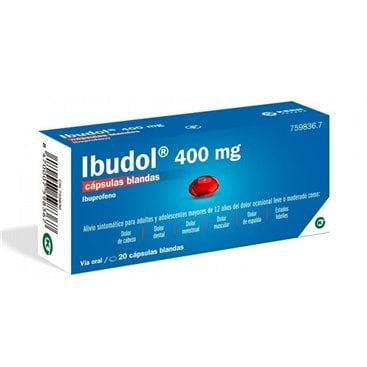Ibudol 400 Mg 20 Soft Capsules
Ibudol 400 Mg 20 Soft Capsules is indicated in adults and adolescents over 12 years of age for the symptomatic relief of occasional mild or moderate pain, such as headache, dental, menstrual, muscle or back pain, as well as in febrile states.
Ibudol 400 Mg 20 Soft Capsules is indicated in adults and adolescents over 12 years of age for the symptomatic relief of occasional mild or moderate pain, such as headache, dental, menstrual, muscle or back pain, as well as in febrile states.
Ibudol (400 Mg 20 Softgels)
ACTION AND MECHANISM
Ibuprofen is a propionic acid derivative with anti-inflammatory, analgesic and antipyretic activity. Its mechanisms of action could be due to the inhibition of peripheral prostaglandin synthesis through its competitive and reversible binding to the cyclooxygenase enzyme, which transforms arachidonic acid into prostaglandins.
PHARMACOKINETICS
Absorption: Good and rapid oral absorption, with a bioavailability of 80% and a Tmax of 1-3 hours, depending on the pharmaceutical form. Arginine and lysine salts promote the solubilization of ibuprofen, allowing for even faster absorption (Tmax of 20-30 minutes). The antipyretic effects begin after one hour, are maximum at 2-4 hours and can last for periods of 6-8 hours. Up to 2 weeks of treatment may be required to achieve anti-inflammatory effects. Food delays absorption by around 30-60 minutes and reduces Cmax by 30-50%, although it does not affect the total amount absorbed.
Distribution: High binding to plasma proteins (90-99%). Volume of distribution (Vd) of 0.1-0.2 l/kg. It diffuses well, passes into synovial fluid and crosses the placental barrier. It has not been detected in milk of lactating women (detection limit 0.5 mcg/ml).
Metabolism: Extensive metabolism in the liver by hydroxylation and carboxylation of the isobutyl group, generating several inactive metabolites.
Elimination: Mainly in urine (90%; 50-60% major metabolites and their glucuronides and < 10% unchanged), with minor amounts in feces. The elimination half-life (t1/2) is 2-4 hours, and elimination is complete after 24 hours.
INDICATIONS
- Treatment of mild to moderate pain.
- Symptomatic treatment of fever.
POSOLOGY
- Adults: 400 mg every 6-8 hours. Maximum dose 1,200 mg in 24 hours.
- Adolescents from 12 years of age (> 40 kg): 400 mg every 6-8 hours. Maximum dose 1,200 mg in 24 hours.
- Children < 12 years (< 40 kg): Use presentations adapted to this age.
- Elderly: May require a dose reduction.
Administration with food: Administer with food.
Duration of treatment: Consult the doctor and/or pharmacist in case of worsening of symptoms or persistence for more than 5 days (pain) or 3 days (fever).
Forgotten dose: Administer the next dose at the usual time. Do not double the next dose.
DOSAGE IN KIDNEY FAILURE
- Mild to moderate renal impairment (CLcr 30-90 ml/min): Use with caution at the lowest possible dose.
- Severe renal failure (CLcr < 30 ml/min): Contraindicated.
DOSAGE IN LIVER FAILURE
- Mild to moderate hepatic impairment (Child-Pugh classes A and B): Use with caution at the lowest possible dose.
- Severe hepatic insufficiency (Child-Pugh class C): Contraindicated.
RULES FOR CORRECT ADMINISTRATION
Administration with food: Administer with food.
- Tablets and capsules: Swallow with a glass of water.
ADVICE TO THE PATIENT
- Inform your doctor if you experience skin rashes, symptoms related to a gastroduodenal ulcer (epigastric pain or dark stools), visual disturbances, weight gain, edema or prolonged headache.
- Notify your doctor if you have had any asthmatic reaction while taking this medication.
CONTRAINDICATIONS
- Hypersensitivity to ibuprofen or any component of the medication.
- Active or recurrent peptic ulcer, active inflammatory bowel disease, or any process that increases the risk of gastrointestinal bleeding.
- Coagulation disorders.
- Perioperative pain in the setting of a coronary bypass.
- Severe renal failure (CLcr < 30 ml/min).
- Severe liver failure (Child-Pugh class C).
- Severe heart failure (NYHA class III-IV) or uncontrolled high blood pressure.
- Pregnancy: Contraindicated during the third trimester.
PRECAUTIONS
- Kidney failure: Risk of accumulation and toxicity. Monitor kidney functionality.
- Liver failure: Risk of accumulation and toxicity. Monitor liver function.
- History of peptic ulcer: Increased risk of ulcer and gastrointestinal bleeding. Administer with food and consider an antiulcer drug in risk groups.
- Inflammatory bowel disease: It could precipitate symptomatic crises.
- Cardiovascular effects: Risk of fluid retention, high blood pressure, and heart failure. Evaluate other cardiovascular risk factors before starting long-term treatment.
- Skin reactions: Risk of serious reactions such as exfoliative dermatitis, Stevens-Johnson syndrome and toxic epidermal necrolysis. Discontinue at the first sign of hypersensitivity.
- Chronic asthma: Risk of bronchospasm. Take extreme precautions.
- Aseptic meningitis: Risk in patients with systemic lupus erythematosus and other collagenoses.
INTERACTIONS
- NSAIDs: Avoid simultaneous use. May reduce the antiplatelet efficacy of acetylsalicylic acid.
- Alcohol: Enhances toxicity.
- Oral anticoagulants, heparin: Risk of bleeding. Control coagulation rates.
- SSRI antidepressants: Increased risk of bleeding.
- Antihypertensives (ACE inhibitors, beta-blockers): Reduction of the antihypertensive effect.
- Corticosteroids: Increase in gastric discomfort.
- Digitalis: Risk of increased plasma concentrations.
- Diuretics: Reduction of the natriuretic and diuretic effect.
- Lithium: Increased toxicity.
- Methotexate: Increased risk of toxicity.
- Paracetamol: Increased risk of adverse kidney effects.
PREGNANCY
- First and second trimester: May cause oligohydramnios and constriction of the ductus arteriosus. Use only if strictly necessary.
- Third trimester: Contraindicated due to cardio-pulmonary toxicity, renal dysfunction, prolongation of bleeding time, and inhibition of uterine contractions.
LACTATION
- Safety in humans: Ibuprofen is excreted in low concentrations in breast milk. It can be used during breastfeeding to treat pain and fever.
CHILDREN
- It is not recommended for children under 3 months. It should not be self-medicated in children under 12 years of age.
ADVANCED AGE
- Caution due to increased risk of gastrointestinal adverse reactions, especially bleeding and perforation.
EFFECTS ON DRIVING
- Refrain from driving or operating machinery if you experience dizziness, vertigo, visual disturbances or other central nervous system disorders.
ADVERSE REACTIONS
- Gastrointestinal: Dyspepsia, diarrhea, nausea, vomiting, abdominal pain, gastrointestinal bleeding, gastric and duodenal ulcer, oral thrush, intestinal perforation, melena.
- Dermatological/Hypersensitivity: Skin rashes, urticaria, pruritus, angioedema, rhinitis, bronchial spasm, anaphylaxis, erythema multiforme, toxic epidermal necrolysis, Stevens-Johnson syndrome, allergic vasculitis.
- Central nervous system: Asthenia, drowsiness, headache, dizziness, vertigo, insomnia, anxiety, psychosis, nervousness, irritability, depression, confusion.
- Hematological: Thrombocytopenia, leukopenia, granulocytopenia, pancytopenia, agranulocytosis, aplastic anemia, hemolytic anemia.
- Cardiovascular: Edema, high blood pressure, heart failure.
- Renal: Increased urea nitrogen, serum creatinine, acute renal failure, interstitial nephritis, glomerulonephritis, renal medullary necrosis, nephrotic syndrome, proteinuria, hyperkalemia, hypokalemia.
- Hepatic: Increased transaminases, hepatitis, jaundice.
- Otological: Tinnitus.
- Ophthalmic: Blurred vision, dyschromatopsia, reversible toxic amblyopia.
OVERDOSE
- Symptoms: Toxic effects from doses of 80-100 mg/kg, with symptoms such as abdominal pain, nausea, vomiting, headache, drowsiness, lethargy, nystagmus, tinnitus and ataxia. In severe cases, gastrointestinal bleeding, hypotension, hypothermia, metabolic acidosis, seizures, renal failure, coma, respiratory distress.
- Treatment: There is no specific antidote. Administer activated charcoal and forced emesis if the overdose is greater and less than an hour has passed. Gastric lavage in potentially fatal overdoses. Symptomatic treatment for hypotension, gastrointestinal bleeding and metabolic acidosis. Elimination by hemodialysis is not expected.



